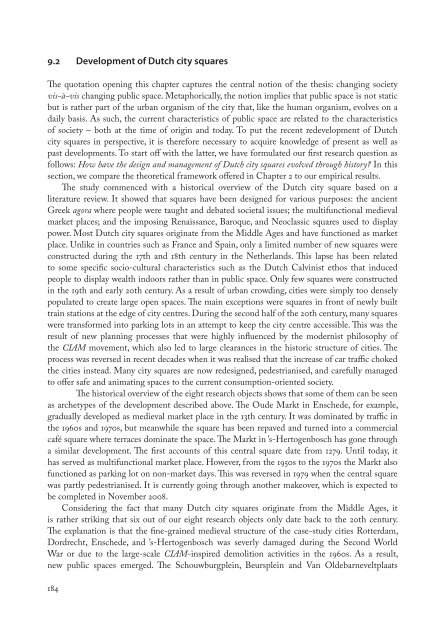Changing public space
Changing public space
Changing public space
Create successful ePaper yourself
Turn your PDF publications into a flip-book with our unique Google optimized e-Paper software.
9.2 Development of Dutch city squares<br />
The quotation opening this chapter captures the central notion of the thesis: changing society<br />
vis-à-vis changing <strong>public</strong> <strong>space</strong>. Metaphorically, the notion implies that <strong>public</strong> <strong>space</strong> is not static<br />
but is rather part of the urban organism of the city that, like the human organism, evolves on a<br />
daily basis. As such, the current characteristics of <strong>public</strong> <strong>space</strong> are related to the characteristics<br />
of society – both at the time of origin and today. To put the recent redevelopment of Dutch<br />
city squares in perspective, it is therefore necessary to acquire knowledge of present as well as<br />
past developments. To start off with the latter, we have formulated our first research question as<br />
follows: How have the design and management of Dutch city squares evolved through history? In this<br />
section, we compare the theoretical framework offered in Chapter 2 to our empirical results.<br />
The study commenced with a historical overview of the Dutch city square based on a<br />
literature review. It showed that squares have been designed for various purposes: the ancient<br />
Greek agora where people were taught and debated societal issues; the multifunctional medieval<br />
market places; and the imposing Renaissance, Baroque, and Neoclassic squares used to display<br />
power. Most Dutch city squares originate from the Middle Ages and have functioned as market<br />
place. Unlike in countries such as France and Spain, only a limited number of new squares were<br />
constructed during the 17th and 18th century in the Netherlands. This lapse has been related<br />
to some specific socio-cultural characteristics such as the Dutch Calvinist ethos that induced<br />
people to display wealth indoors rather than in <strong>public</strong> <strong>space</strong>. Only few squares were constructed<br />
in the 19th and early 20th century. As a result of urban crowding, cities were simply too densely<br />
populated to create large open <strong>space</strong>s. The main exceptions were squares in front of newly built<br />
train stations at the edge of city centres. During the second half of the 20th century, many squares<br />
were transformed into parking lots in an attempt to keep the city centre accessible. This was the<br />
result of new planning processes that were highly influenced by the modernist philosophy of<br />
the CIAM movement, which also led to large clearances in the historic structure of cities. The<br />
process was reversed in recent decades when it was realised that the increase of car traffic choked<br />
the cities instead. Many city squares are now redesigned, pedestrianised, and carefully managed<br />
to offer safe and animating <strong>space</strong>s to the current consumption-oriented society.<br />
The historical overview of the eight research objects shows that some of them can be seen<br />
as archetypes of the development described above. The Oude Markt in Enschede, for example,<br />
gradually developed as medieval market place in the 13th century. It was dominated by traffic in<br />
the 1960s and 1970s, but meanwhile the square has been repaved and turned into a commercial<br />
café square where terraces dominate the <strong>space</strong>. The Markt in ’s-Hertogenbosch has gone through<br />
a similar development. The first accounts of this central square date from 1279. Until today, it<br />
has served as multifunctional market place. However, from the 1950s to the 1970s the Markt also<br />
functioned as parking lot on non-market days. This was reversed in 1979 when the central square<br />
was partly pedestrianised. It is currently going through another makeover, which is expected to<br />
be completed in November 2008.<br />
Considering the fact that many Dutch city squares originate from the Middle Ages, it<br />
is rather striking that six out of our eight research objects only date back to the 20th century.<br />
The explanation is that the fine-grained medieval structure of the case-study cities Rotterdam,<br />
Dordrecht, Enschede, and ’s-Hertogenbosch was severly damaged during the Second World<br />
War or due to the large-scale CIAM-inspired demolition activities in the 1960s. As a result,<br />
new <strong>public</strong> <strong>space</strong>s emerged. The Schouwburgplein, Beursplein and Van Oldebarneveltplaats<br />
184




